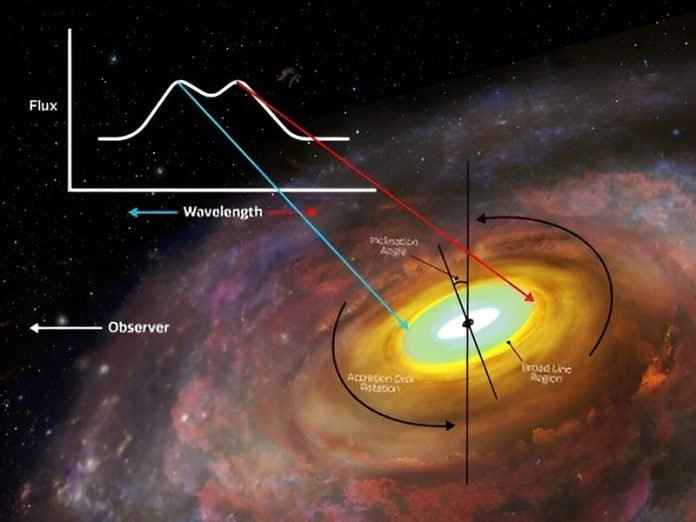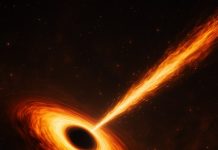
Imagine a supermassive black hole sitting at the center of a far-off galaxy.
Around this black hole, there’s a spinning whirlpool of gas and dust called an “accretion disk.”
This disk feeds the black hole and also gives off a lot of light in various forms.
While it’s a fascinating subject, it’s really hard to actually see these disks with our telescopes because they are so far away and small.
However, a team of scientists from Brazil has managed to spot some unique light patterns coming from one of these disks for the first time ever!
They used a special telescope called the Gemini North, which can capture various types of light all at once.
By looking at how the light changes as it comes from the disk, they can tell a lot about what’s happening around the black hole.
When an atom gets excited and then calms down, it gives off light. This light is like a unique signature that tells scientists which atom it came from.
Usually, the light appears as thin spikes on their equipment. But near a black hole, these spikes look more like little hills because everything is swirling around so fast.
By studying this, scientists can find a pattern that proves there’s an accretion disk spinning around a black hole.
This pattern has two peaks, like two hills next to each other, because one side of the disk is moving towards us and the other is moving away. Seeing this double-peak is rare and gives valuable information about the disk.
The scientists didn’t just find this pattern in the usual visible light but also in near-infrared light, which is a type of light we can’t see with our eyes. This is the first time anyone has seen this kind of pattern in near-infrared light, and it gives us a closer look at areas near the black hole that we’ve never seen before.
The scientists’ work shows that the spinning disk is tilted at an angle of 18 degrees compared to our line of sight from Earth.
They also figured out how big the disk is, which helps us understand the size and mass of the black hole itself. According to their calculations, the black hole could be 400 to 900 million times heavier than our Sun!
Now, the team is keeping a close eye on the same galaxy, known as III Zw 002, to see if the pattern changes over time. If it does, that could give us even more information about what’s happening around these mysterious black holes.
This breakthrough opens up new ways to study other galaxies and their black holes, helping us understand the cosmic monsters lurking at the centers of galaxies a little better.
The full details are published in a science journal, but for now, let’s celebrate this cosmic peek into the unknown!
The study was published in the journal The Astrophysical Journal Letters.
Follow us on Twitter for more articles about this topic.
Source: NSF’s NOIRLab.



